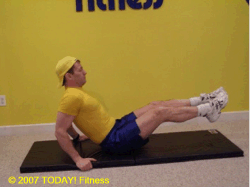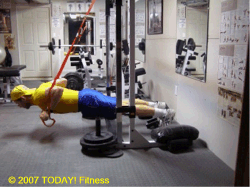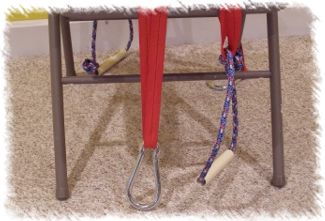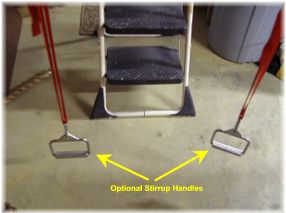|
Thirsty is Too
Late! |
|
Paying attention to your sweat means the difference between
dragging through a workout and finishing strong. Athletic
performance starts to suffer once you lose about 2 percent of your
body weight during a workout. Few people really know how much
liquid that their body needs which is not surprising, given the number
of conflicting reports there are.
Relying on thirst as an
indicator of how much fluid is lost is not an accurate method.
If you relied on thirst, you would only put back 50 to 75% of the
fluid that you lost and you would start your next workout already in a
state of dehydration. Do not wait until you are thirsty to
drink, and do not stop drinking once your thirst has been quenched.
Water lubes your muscles, transports nutrients around your system,
and shuttles waste out of it, allowing your kidneys to function
smoothly. When you've sweated out 1 percent of your body weight,
two things happen (and continue to happen with every additional 1
percent loss): Your heart rate rises 7 beats per minute in order
to push your thickening blood through your body, and your core
temperature increases a third of one degree. Lose 2 percent and
not only are you physically suffering (your pace slows), but your
brain starts going whacky due to being made up of 80% water.
Your reaction time becomes longer and you have trouble finishing
certain tasks. Becoming even more dehydrated and you might get
headaches, cramps, and dizziness as your body has more difficulty
transporting blood efficiently. Lose 15 percent and your body is
too dried out to stay alive.
The more active you are, the more water you need...this goes
without saying. The notion of 8 glasses of water will suffice
for everyone is completely incorrect, but is a good benchmark for
sedentary or minimally active people. According to the American
College of Sports Medicine, you should start your workout with a full
tank, then replenish your fluids based on your pre- and post-workout
weight. More specifically, ACSM states that you should drink 12
ounces of fluid 4 hours before your workout and then weigh yourself.
If your pee is the shade of apple juice or darker, plan on drinking
another 8 to 12 ounces 2 hours before you exercise. During your
workout, it is advisable to consume 4 to 8 ounces of fluid every
10 to 15 minutes.
Rather than drinking bottle after bottle all at once after a
workout, it is advised to sip no more than 16 ounces an hour.
Your body can't process bottles of water rapidly and, although your
urine won't be as yellow, you will be peeing too often to become
sufficiently hydrated. ACSM guidelines are to drink 16 ounces
per every pound lost during an hour long workout. When working
out twice in a day, 20-24 ounces per pound of weight lost is advised.
Also, if you consume a lot of caffeine or alcohol, which are both diuretics,
you will have pale or clear urine even though you are, in fact,
dehydrated.
Researchers at the University of Texas found that women lost an
average of 1.2 liters an hour during moderate-intensity exercise in a
warm environment while men pumped out 1.6 liters. This is rough
guideline based upon research, so you will want to do the pre- and
post-workout weight check to understand your own fluid loss average.
Hydration is an important factor for both your health and performance
and should be a priority for any active individual!
ref:
Womens Health, 11/2007
|
|
How Much is
Enough? |
|
I know a lot of people that are
religious about their workouts and that will plug away at
their routines week after week. This is certainly
commendable, but I sometimes have to bite my tongue when I
see them going through the paces with less than adequate
intensity. With several ways to increase the intensity
of the workout, there should be no reason not to get the
most benefit possible in the time that you are putting in.
As a general guideline, the
weight that you are working with should leave you red-faced
and weak. By the last repetition, you should feel as
though you have to put the weight down. The number of
repetitions that you do should be pre-determined prior to
beginning your set. It is often good to change this up
once in a while. Choose a weight that you can lift for
8-12 reps (moderate weight) one week, 12-15 (light weight)
the next week, and then 6-8 reps (heavy weight) after that.
This type of variance is good for building muscle which also
burns more fat.
Another good practice is to
allow about a minute between your sets for maximum burn.
This keeps your heart rate elevated and your metabolism
cranking for additional calorie burning. As a rule of
thumb, a longer rest/recovery period will allow you to lift
more during the next set, thereby helping to build more
mass, whereas shorter rest periods will provide more of a
cardio type workout if that is part of the effect you are
going for.
It's good to keep as many
muscles involved as possible. When prioritizing your
exercises, choose compound exercises over isolation
exercises. You can think of a compound exercise as one
that involves the movement of more than one joint. A
bench press moves the shoulder and the elbow joint working
your chest, shoulders, and triceps whereas a tricep
pressdown involves the elbow joint only and works only the
triceps. A lat pulldown involves the shoulder and
elbow joint in a different direction working the back and
biceps whereas most curls involve only the elbow joint and
work only the biceps. Compound exercises work more
muscles for your effort (and time) and therefore do more for
your muscle goals as well as your metabolism and calorie
burn. However, if you are performing an isolation type
exercise, you can add a little more muscle involvement by
choosing alternate forms that involve standing instead of
sitting, or even unstable surfaces (bosu ball, stability
ball) as long as they don't effect your form or cause safety
concerns.
Once again, I'm just
providing a guideline that you can choose to listen to or
ignore. This is often the choice between working out
hard and just enjoying the time that you're there.
Although this is a personal choice, the fact of the matter
is that your benefits are directly proportional to the
effort that you put in. Working out, by its very
nature, causes some degree of discomfort. The physical
adaptations that your body makes is a result of the stress
that you expose it to. If you approach your workout
with this mindset, and you prepare to exert the effort
required to achieve results, you will find that your
benefits will increase significantly. I've said it
before... they don't call it WORKing out for nothing!
|
|
Try
This |
|
Eat a piece of chocolate! ...or
whatever else you find to be a vice for you. Hang on... not so
fast. What I'm trying to say is don't try to deprive yourself
with a hard core diet all at once. Chocolate is my
addiction... but I didn't drop it completely either. I'll
allow myself a little piece or two on the weekend and then do
without it all week. The idea here is that you are much more
likely to stick with the limitation if you have a little break to
look forward to at the end of the week. Be smart and don't go
overboard, but whether it is soda, ice cream, chocolate, whatever...
if you need to cut back on it then make the goal something realistic
that you can stick to. If your weakness is a daily kind of
thing, and a week is too long, then shoot for a few days to start.
If it's not as frequent, maybe you can make a month. But
decide ahead of time and make a commitment to yourself to do it.
Goals are much more productive when you are able to adhere to them!
|
|
 |
|
|
Elite
Bodyweight Exercise of the Month! |
|
Seated
Crunch

Summary:
The seated crunch is a good example of an exercise that can be
as challenging as you want it to be. You can perform it
on the ground (as pictured above), in a chair, sitting on a
bench... really any place that you can get into a stable
seated position. The difficulty can be increased by
slowing the tempo, adding ankle weights, putting a medicine
ball or dumbbell between your feet, etc... to increase
resistance.
Target: Abs (rectus abdominis)
Count:
2 count
Description: Starting
in a stable seated position, extend your legs out in front of
you. Crunch your knees towards your chest as far as
possible before returning to the starting position.
Repeat for desired repetitions.
|
|
Have You Been
Suspended? |
|
Suspension Training has received quite a bit
of attention recently. There are a variety of bodyweight exercises
that can be performed with these simple and portable pieces of equipment
and they offer an additional challenge due to the instability of the
exercises. The exercises that can be performed are excellent as
they allow athletes to move their bodies against external resistance in
a multi-dimensional environment.
Since suspension straps are basically just
adjustable loops with handles, they can be rolled up and put in a gym
bag or pouch and taken with you. They can typically be hung from
any stable bar, hook or doorway and are often a favorite for "playground
workouts" for those that are into suspension training.
If you compare a barbell bench press to a
Blast Strap push up, you will notice that the athlete can use the bench,
the floor and the barbell to help stabilize the weight. With the Blast
Strap push up, the body is being moved instead of a barbell and thus the
body has to stabilize itself during the exercise. This incorporates many
more muscles because of the stabilization effect.

Blast Straps are sold by Elite Fitness
Systems.
Although the heavy duty nylon straps, clasps and handles are made very
well, I decided to make a cheap pair myself and save the $60 cost of the
originals. There is another version of these suspension straps out
now called the
TRX system that is being publicized
heavily... not bad if you don't mind paying $149!

As you can see from the
picture above, I used a small amount of rope, some PVC pipe,
some strong cargo tie down or lashing straps (mostly because
they were adjustable) and some heavy duty clips... all of
which I picked up at home depot for about $10-$15.
Depending on what you want to put into them, you can include
actual cable handles (stirrup handles) instead of the rope
and pipe method.

For more information, additional
exercises and video representation
click here to go to the
suspension strap page at todayfitness.net.
|
|
It's
Go Time! |
|
Cross your fingers for good
weather on Saturday 10/3 as I'll be doing my annual 75 mile
bike ride for MS. Unfortunately, right now it's not
looking very promising : ( Although this ride
typically marks the end of my bike riding season, I
certainly don't stop doing cardio. That would be way
too much ground to make up come spring time and I'd rather
not start all over again!
Sure I know a bunch of people
that continue riding when it gets cold outside, but I can't
say that motivates me in the least. No, when it gets
chilly outside is when I mix up my cardio between my
elliptical, P90X+ DVDs, or even my old TAE BO Advanced tape.
I like to get in 35-45 minutes of something, 2-3 times per
week... preferably interval training for the most beneficial
workout in the time that I have. During the rest of
the week is when I hit my various resistance training
workouts.
With a very busy work,
family, and personal life... I never really plan on rest
days. I pretty much just plan to do some type of
workout every day... this way, when those unexpected issues
pop-up (and they do) I don't feel as bad about missing a
workout. But hey... that's just me. I only offer
this up for those of you that may find this strategy
helpful. Either way, keep up or get into a routine
that works for you... you have a whole 8 months to go before
next summer!
For prior issues of this
newsletter go to
www.todayfitness.net/news.
Exceed Your
Potential!
Pete
Mazzeo, CPT
pmazzeo@todayfitness.net
"It's not a problem that we have a
problem,
it's a problem if we don't deal with the
problem." -Mary Kay Utech
youtube video of the month -->
Shoulder Rehab
Solid set of shoulder exercises for injury prevention and
rehab.
| |